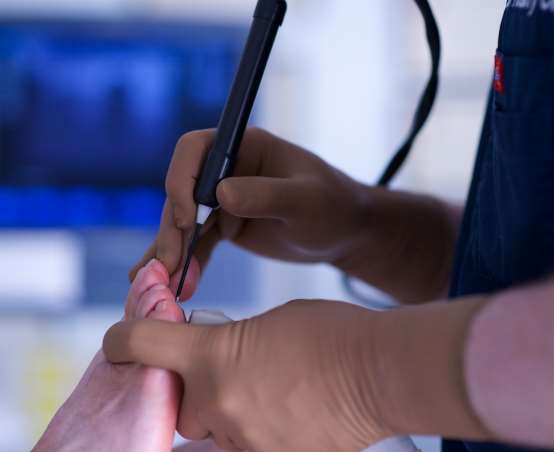Cryotherapy for Morton's Neuroma IN UPPER EAST SIDE, NYC
BOARD CERTIFIED PODIATRIST & SPORTS MEDICINE
Serving Upper East Side, Manhattan, Midtown, NYC, NY and the surrounding areas.

Cryotherapy for neuroma involves applying cold temperatures to the affected nerve tissue, aiming to reduce inflammation and alleviate pain. This minimally invasive approach treats the abnormal nerve tissue. It destroys it while leaving the native nerve intact and providing relief for individuals with neuroma symptoms.
Cryosurgery for Morton's Neuroma in Upper East Side NYC
What is Morton's Neuroma and How Does Cryotherapy Help?
Have you ever felt like there’s a pebble stuck in your shoe, yet nothing’s there? That irritating sensation could be Morton’s Neuroma, a common yet painful condition. If you’re an active New Yorker, dealing with foot issues can be a real setback.
Understanding Morton’s Neuroma
Morton’s Neuroma might sound like a fancy term. But it’s really just a troublesome foot issue that affects many.
Imagine the nerve between your toes thickening and swelling because it’s been squeezed and irritated over time. The result? Pain, and lots of it, right in the ball of your foot.
Symptoms of Morton’s Neuroma
The symptoms are not mysterious; they make their presence known quite effectively. You might experience sharp, burning pain or even a feeling that there’s something inside the ball of your foot. Numbness or tingling in your toes can also occur.
Causes of Morton’s Neuroma
So, what triggers this annoying foot fiend? It’s often due to repetitive stress on the feet—something that’s not uncommon for bustling New Yorkers. High heels or tight shoes cramp the toes and contribute significantly to the problem. It’s like forcing your foot into a tiny apartment it can barely afford—eventually, something’s got to give!
Cryotherapy NYC
Cryosurgery, also known as cryotherapy, is a medical procedure that uses extreme cold to treat neuromas. A neuroma is a benign growth of nerve tissue that can cause pain, tingling, or other sensory disturbances. Cryosurgery for neuromas involves using cold temperatures to destroy or remove the abnormal nerve tissue.
Here’s how cryosurgery for neuromas typically works:
1. Local Anesthesia:
The patient is usually given a local anesthetic to numb the area around the neuroma. This ensures that they do not feel pain during the procedure.
2. Cryoprobe Placement:
A small cut is made. Then a cryoprobe, which is a specialized instrument, is inserted into the area where the neuroma is located. The cryoprobe is then cooled to extremely low temperatures, using liquid nitrogen.
3. Freezing the Neuroma:
The cryoprobe generates freezing temperatures, which cause the abnormal nerve tissue of the neuroma to freeze and die. The freezing process destroys the defective nerve tissue and interrupts the pain signals.
4. Thawing:
After the freezing period, the cryoprobe is removed, allowing the tissue to thaw naturally.
5. Recovery:
Patients may experience some discomfort and swelling in the treated area after the procedure. However, this typically subsides within a few days to weeks.
Cryotherapy in Upper East Side Manhattan
Cryosurgery is considered a minimally invasive procedure, and is performed on an outpatient basis. It is a relatively quick procedure. Patients can walk immediately afterwards, and can usually return to their normal activities within a short time.
Cryosurgery works well for neuromas when other treatments like physical therapy or orthotics haven’t helped. However, like any medical procedure, it carries some risks and potential side effects, including infection or scarring.
Aire Podiatry’s Cryotherapy Service
At Aire Podiatry, our advanced cryotherapy is made for busy New Yorkers dealing with foot and ankle problems. We get your active lifestyle and offer treatments that keep you going strong, without missing a beat.
Impact on Patients’ Lives
Imagine being able to stroll through Central Park or dash up the subway stairs without that nagging foot pain. Aire Podiatry’s cryotherapy service has made this a reality for many. Patients often report significant pain relief and improved mobility. It’s not just treatment; it’s a doorway to a more active, fulfilling life without the burden of foot pain.
Treatment for Morton’s Neuroma Surgery in NYC
If you love working out or just want to stroll without pain, dealing with Morton’s Neuroma matters. Cryosurgery procedures offer a modern way to beat this painful problem. Don’t let foot pain hold you back. Consider cryosurgery for Morton’s Neuroma and step into a life of comfort and activity.
Talk to one of our skilled podiatrists to find out if cryosurgery is right for your neuroma. They’ll chat with you about what could help and any possible downsides.

